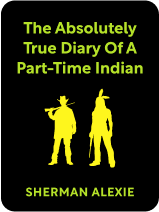

This article is an excerpt from the Shortform summary of "The Absolutely True Diary of a Part-Time Indian" by Sherman Alexie. Shortform has the world's best summaries of books you should be reading.
Like this article? Sign up for a free trial here .
What is The Absolutely True Diary of a Part-Time Indian timeline? When does the book take place, and when do key events happen?
The Absolutely True Diary of a Part-Time Indian timeline occurs over the course of a single school year. It begins in the summer before Junior’s freshman year, and ends the following summer. This is an eventful year for Junior, as he switches schools, loses several people who are important to him, and fights with his best friend.
Keep reading for the full The Absolutely True Diary of a Part-Time Indian timeline.
The Absolutely True Diary of a Part-Time Indian Timeline
Read this The Absolutely True Diary of a Part-Time Indian timeline to find out when and where major events in the book happened.
The End of Summer
What happens at the end of summer in The Absolutely True Diary of a Part-Time Indian timeline? Junior says that most people think the worst thing about being poor is being hungry. He acknowledges that sometimes, he and his family go upwards of 18 hours without eating because they don’t have the money for food. But Junior always knows that eventually, one of his parents will come home with KFC. And KFC tastes even better when you’re hungry.
Junior sometimes wants to blame his parents for their poverty, but he knows he can’t. He knows his family’s poverty is not his parents’ fault, and he knows they dreamed of more. But no one on the reservation realizes their dreams. They don’t get the chance. They’re too poor. And that creates a cycle that’s hard to escape.
- First, you believe you’re poor because you’re stupid.
- Then, you believe you’re stupid because you’re Indian.
- Finally, because you’re Indian, you believe you will always be poor, and the cycle repeats itself.
Poverty doesn’t make you strong or perseverant. Poverty just “teaches you how to be poor.”
Early Fall
What happens during early fall in The Absolutely True Diary of a Part-Time Indian timeline? When his parents get home, Junior asks them, “Who has the most hope?” His parents look uneasily at each other, unsure of how to answer, but when Junior asks again, they say, at the same time, “white people.”
Junior knew they’d say that. Now he knows for sure where he and his hope need to go: to Reardan, the rich, redneck, racist farm town where the white kids go to school.
For a kid on the rez, saying, “I want to go to Reardan” is like saying, “I want to fly to the moon.” No one leaves the reservation, certainly not to go to another school, and certainly not a white school. But Junior’s parents put up little resistance. Even though Junior’s dad once got pulled over in Reardan three times in one week for DWI (Driving While Indian), Junior’s parents know Reardan is one of the best schools in the state. They suggest he wait until the following school year, but Junior insists that if he doesn’t start the following day, he never will. Junior’s parents agree. It’s as if they’ve been waiting for Junior to ask to go to Reardan. Like Mr. P, they see their son’s potential and don’t want him to end up drunk and impoverished like the rest of the Indians on the rez.
Late Fall
What happens during late fall in The Absolutely True Diary of a Part-Time Indian timeline? When Junior gets home the day he contradicts his geology teacher, he finds his mother crying. His sister has gotten married to a Flathead Indian she’s just met at the casino and has moved to Montana. She didn’t tell anyone she was going. She just called her mom from Montana to let her know she was married.
Since 1881, when the Spokane Reservation was founded, no one in Junior’s family has left, and now Junior’s parents have lost both their children to the “outside world.” Junior wonders if they feel like failures.
At first, Junior is worried about his sister. But then he realizes that his sister is trying to live her dreams. She’s living the romance novel she always wanted to write. This is a step up from isolating herself in the basement. The move proves to Junior that Mary’s spirit hadn’t died. She hasn’t given up. It’s a big deal for anyone to leave the rez, and Junior is proud of her. He also realizes that he’d shamed her by leaving first. His bravery had inspired hers.
Late Winter
In February, Eugene and his friend Bobby, both drunk, argue in a 7-Eleven parking lot over who gets the last sip of wine. Bobby shoots Eugene in the face, killing him. Once in jail (and sober), Bobby hangs himself.
Junior has no idea how to deal with his grief. He copes by reading lots of books and drawing lots of cartoons. He loses track of how many days of school he’s missed—fifteen, maybe twenty.
Junior wonders why God would make his family suffer so much. He finds his answer in the Euripides play Medea, which Gordy has shown him. In it, the title character asks, “What greater grief than the loss of one’s native land?” This hits a chord. Junior suddenly understands his family’s grief and the suffering of his community on the rez: Indians have lost their native land. In fact, they’ve lost everything: their languages, their dances, their songs, and their relationships with each other. The only way of life they know is “how to lose and be lost.”
Junior’s so angry at this unfairness that he wants to kill God. He also thinks he’s cursed his family and his tribe by leaving Wellpinit to go to school at Reardan. He blames himself for his grandmother’s and Eugene’s deaths, and he thinks about leaving Reardan for good.
Spring and Summer
What happens during spring and summer in The Absolutely True Diary of a Part-Time Indian timeline? As the school year comes to a close, Junior and his parents go to the cemetery to clean the graves. Junior’s mom tells him how proud she is of him, which is the greatest thing she could have said, as far as he’s concerned. He understands that he can be happy while still missing his sister.
Junior cries thinking about how amazing his sister was. She pursued her dreams. She never reached them, but it was the bravery of the attempt that mattered. Junior sees that, like his sister, he’s also making the attempt, and it also might kill him, but staying on the rez also would have killed him.
Junior cries for:
- His sister and her premature death
- Himself and the fact that he’s the only one who’s been brave and arrogant enough to leave the rez and find a “better life out in the white world”
- His tribe, many of whom will die in the coming year due to the effects of alcohol
But Junior’s not alone in his grief, or his bravery. He’s in the company of millions of Americans who’ve “left their birthplaces in search of a dream.” He’s a member of the Spokane tribe, but he’s also a member of many other tribes, including:
- The basketball tribe
- The bookworm tribe
- The cartoonist tribe
- The teenage-boy tribe
- The poverty tribe
- The funeral-goers tribe
- The American immigrants tribe
- The tortilla-chip-lovers tribe
- The boys-who-miss-their-best-friends tribe
Understanding that his world is bigger than the Spokane and that he’s a member of many different tribes, Junior knows that even through his grief, he’s going to be okay. But he also worries about the people he loves who may not be okay, like Rowdy.

———End of Preview———
Like what you just read? Read the rest of the world's best summary of Sherman Alexie's "The Absolutely True Diary of a Part-Time Indian" at Shortform .
Here's what you'll find in our full The Absolutely True Diary of a Part-Time Indian summary :
- How Junior gets split between two worlds when he goes to a mostly white school
- How Junior overcomes being an outsider to being part of welcoming social circles
- The tragedies of alcoholism and poverty that leave Junior with renewed strength






